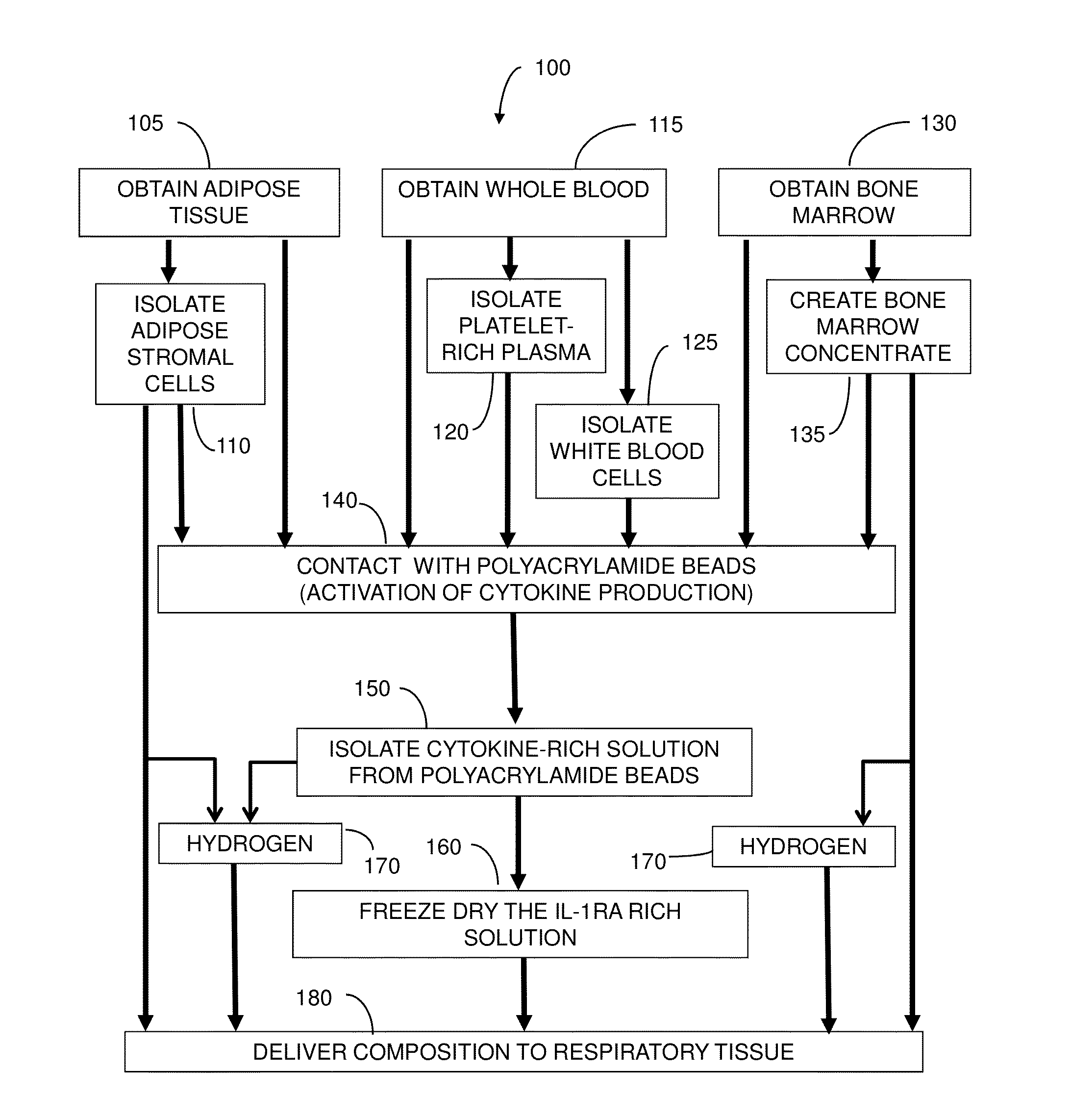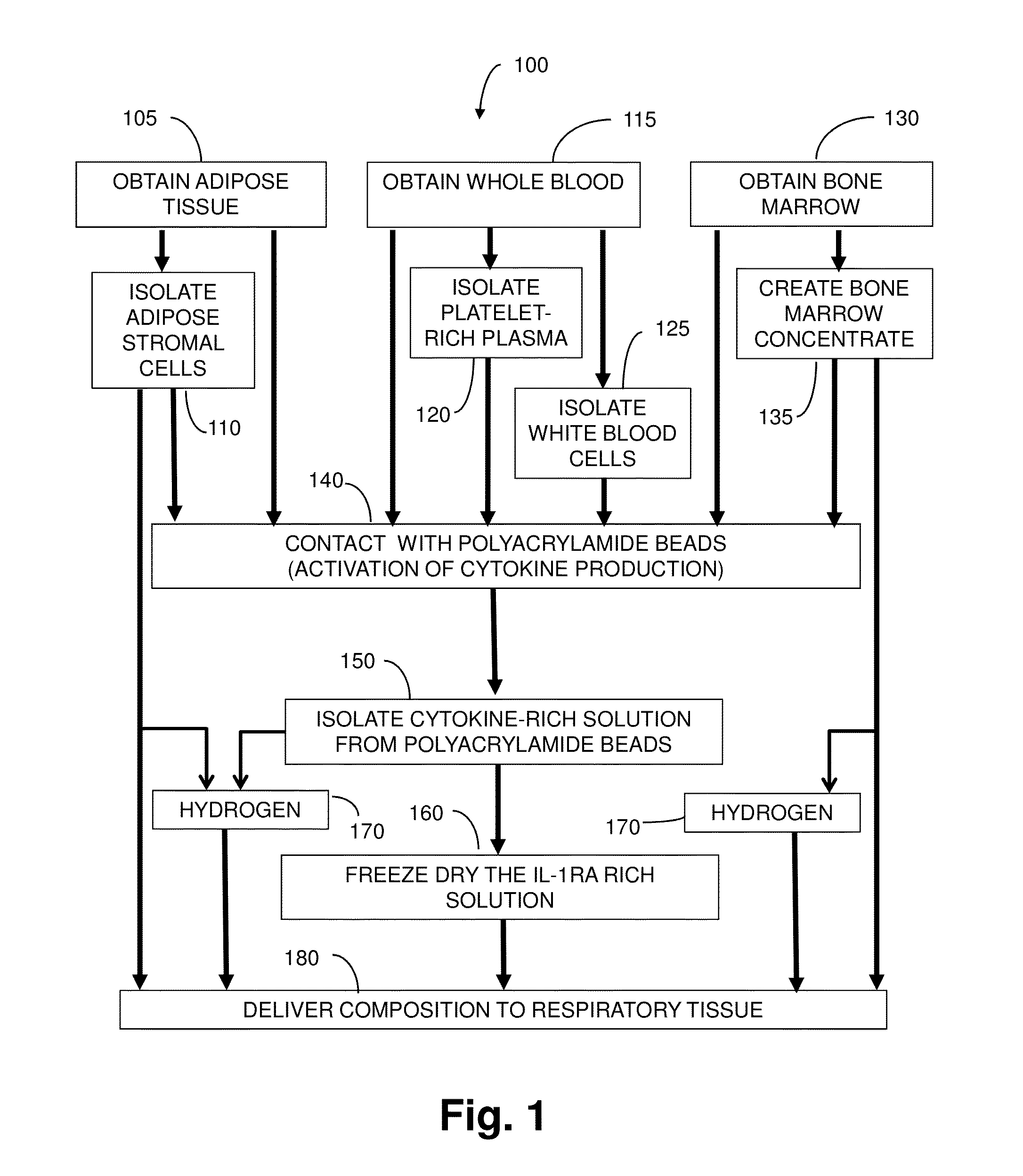Treatment of inflammatory respiratory disease using biological solutions
a technology of respiratory disease and biological solution, applied in the direction of biocide, drug composition, peptide/protein ingredients, etc., can solve the problems of reducing the ability of the airway and alveoli to transfer gases into and out of the bloodstream, affecting the ability of the airway and alveoli to heal, and affecting the function of the respiratory system. , to achieve the effect of reducing free radical generation, enhancing alveolar cell proliferation, and reducing lung inflammation
- Summary
- Abstract
- Description
- Claims
- Application Information
AI Technical Summary
Benefits of technology
Problems solved by technology
Method used
Image
Examples
example 1
Preparing and Characterizing a Protein Solution
[0180]A Protein Solution rich in interleukin-1 receptor antagonist is prepared from seven consented human providers. Blood (55 mL) is drawn into a 60 cc syringe with 5 mL of anticoagulant citrate dextrose solution A (ACD-A, Citra Labs, Braintree, Mass.). Platelet-rich plasma (PRP) is created using the GPS® III platelet concentration system (800-1 003A, Biomet Biologics, Warsaw, Ind.) according to the instructions for use. The solution is generated by adding 6 mL of PRP to a modified Plasmax device containing 1 gram of polyacrylamide beads (Biomet Biologics, Warsaw, Ind.). The IL-Ira solution is removed from the Plasmax devices and frozen at minus 50° C. for the assay. Cytokine content is assayed on a 16-plex ELISA (Searchlight Protein Array, Aushon Biosystems, Billerica, Mass.). The analytes included IL-4, IL-10, IL-11, IL-13, IL-Ira, IFN-γ, sTNF-RI, sTNF-RII, IL-1α, IL-1β, TNF-α, IL-17, IL-18, bFGF, TBF-β1, and TBF-β2.
[0181]The solutio...
example 2
Generation of IL-1ra from Platelet-Rich Plasma
[0182]An IL-1ra-rich solution is created as follows. Whole blood (70 mL) anticoagulated (10%) with ACD-A (Braintree, Mass., USA) is drawn from 5 healthy volunteers. A portion (10 mL) is reserved for a whole blood measurement. Platelet-rich plasma (PRP) (6 mL) is produced using the GPS® II System (Biomet Biologics, LLC, Warsaw, Ind., USA). Complete blood counts are collected for the whole blood and PRP samples following a validated procedure, as described in Woodell-May J E, Ridderman D N, Swift M J, Higgins J. “Producing Accurate Platelet Counts for Platelet Rich Plasma: Validation of a Hematology Analyzer and Preparation Techniques for Counting” J. Craniofac. Surg. (2005) September 16(5):749-56.
[0183]Following the PRP production, 5 mL of the PRP is added to a modified plasma concentration device (Plasmax™, Biomet Biologics LLC, Warsaw, Ind., USA) and incubated with polyacrylamide desiccating beads in the device for 24 hours at room temp...
example 3
Production of Protein Solution from PRP
[0187]Anticoagulated blood (120 cc) is collected from 5 human donors. Platelet-rich plasma (PRP) is prepared using GPS® III disposables (Biomet Biologics LLC, Warsaw, Ind., USA). PRP is loaded into modified plasma concentration devices (Plasmax™, Biomet Biologics LLC, Warsaw, Ind., USA) and processed. The output is divided into 4 groups: IL-1ra in concentrated plasma with and without thrombin activation (1000 U / mL in 1M CaCl2), or cell-free IL-1ra with and without thrombin activation. IL-1ra is measured using ELISA (R&D Systems) over time.
[0188]The PRP contacts polyacrylamide beads in the Plasmax™ device while electromagnetic field stimulation is provided using a capacitively coupled electromagnetic field.
[0189]Unclotted PRP produces an average of about 50 ng over 24 hrs. The cell-free samples produce about 34 ng without changing over 24 hrs. Once clotted, the elution of IL-1ra is slowed, with only about 30% being eluted after 10 hours. Release...
PUM
| Property | Measurement | Unit |
|---|---|---|
| concentration | aaaaa | aaaaa |
| concentration | aaaaa | aaaaa |
| density | aaaaa | aaaaa |
Abstract
Description
Claims
Application Information
 Login to View More
Login to View More - R&D
- Intellectual Property
- Life Sciences
- Materials
- Tech Scout
- Unparalleled Data Quality
- Higher Quality Content
- 60% Fewer Hallucinations
Browse by: Latest US Patents, China's latest patents, Technical Efficacy Thesaurus, Application Domain, Technology Topic, Popular Technical Reports.
© 2025 PatSnap. All rights reserved.Legal|Privacy policy|Modern Slavery Act Transparency Statement|Sitemap|About US| Contact US: help@patsnap.com



